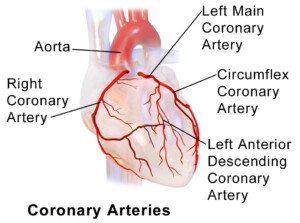A cardiologist addresses the question of ejection fraction being a predictor of mortality.
Ejection fraction is the amount of “squeeze” or force that a heart yields with each beat.
Can this actually be a predictor of mortality?
“If the ejection fraction (EF) is due to poor blood flow to the heart, due to coronary disease, it is a predictor of higher mortality especially if the EF is less than 35%,” explains Dr. Sameer Sayeed, a cardiologist at ColumbiaDoctors of Somers, NY.
Coronary artery disease (CAD) is characterized by plaque buildup inside the artery walls of the heart, which decrease blood flow through the cardiac muscle.

BruceBlaus, CreativeCommons
A diet full of trans fats significantly contributes to this or may even outright cause it.
“If the low EF is due to some unknown cause, perhaps a prior viral infection or just out of the blue, the heart itself is probably pretty normal, and usually the ejection fraction will recover, but until it does there is higher mortality than a normal person, but less than the first scenario I mentioned,” explains Dr. Sayeed.
“Regardless if the EF is less than 35% for more than three months on optimal medical treatment, these people all need defibrillators to prevent sudden cardiac death and decrease their mortality.”
Though ejection fraction then, indeed, plays a role in mortality prediction, it is not the greatest predictor of mortality. That goes to heart rate recovery (HRR).
“Slow heart rate recovery occurs in those people with coronary artery disease and blockages and with heart muscle damaged by this.”
Slow or low HRR also occurs in those who do not exercise sufficiently.

Dr. Sayeed performs echocardiograms and stress tests at the Midtown Manhattan and Westchester offices at Columbia Doctors. He is also trained in cardiac CT imaging.
 Lorra Garrick has been covering medical, fitness and cybersecurity topics for many years, having written thousands of articles for print magazines and websites, including as a ghostwriter. She’s also a former ACE-certified personal trainer.
Lorra Garrick has been covering medical, fitness and cybersecurity topics for many years, having written thousands of articles for print magazines and websites, including as a ghostwriter. She’s also a former ACE-certified personal trainer.
.










































